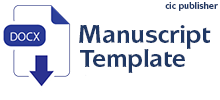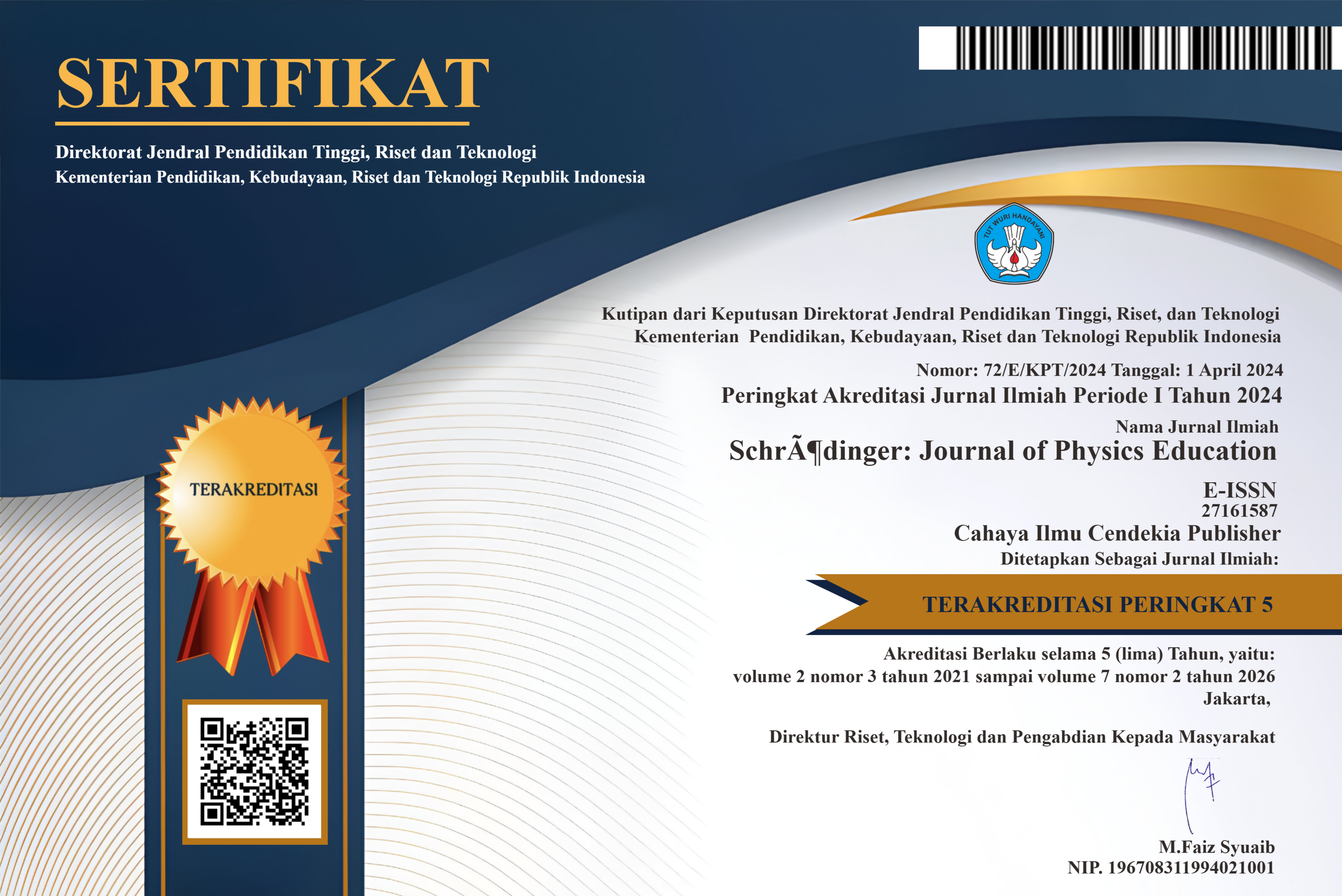Analysis of the Influence of Students' Attitudes on High School Students' Learning Motivation
Abstract
Purpose of the study: The purpose of this study is to find out how the influence of attitudes on motivation to learn about the problems that occur in learning physics.
Methodology: The method used in this study is a quantitative method using survey assessment stages. The sampling technique used simple random sampling with a total sample of 72 high school students. The data collection technique uses a questionnaire on learning motivation and student attitudes. Data analysis used a simple linear regression hypothesis test assisted by SPSS software.
Main Findings: The results of the research and testing of the hypothesis can be concluded that there is a significant positive influence on students' learning attitudes towards physics learning motivation. Each increase in one unit of learning attitude will increase learning motivation by 0.91 units significantly.
Novelty/Originality of this study: The novelty of this research is the discovery of a positive influence of students' learning attitudes on their physics learning motivation. Where every increase of one unit of students' learning attitudes will increase 0.91 students' motivation to learn physics.
References
C. Bellei and G. Munoz, “Models of regulation, education policies, and changes in the education system: a long-term analysis of the Chilean case,” J. Educ. Chang., vol. 24, no. 1, pp. 49–76, 2023, doi: 10.1007/s10833-021-09435-1.
I.-L. Wu, P.-J. Hsieh, and S.-M. Wu, “Developing effective e-learning environments through e-learning use mediating technology affordance and constructivist learning aspects for performance impacts: Moderator of learner involvement,” Internet High. Educ., vol. 55, no. 100871, 2022, doi: 10.1016/j.iheduc.2022.100871.
C. D. T. T. Tran, G. E. Battese, and R. A. Villano, “Administrative capacity assessment in higher education: The case of universities in Vietnam,” Int. J. Educ. Dev., vol. 77, no. December 2019, p. 102198, 2020, doi: 10.1016/j.ijedudev.2020.102198.
Y. Sun, W. Tian, U. Mehmood, X. Zhang, and S. Tariq, “How do natural resources, urbanization, and institutional quality meet with ecological footprints in the presence of income inequality and human capital in the next eleven countries?,” Resour. Policy, vol. 85, no. A, p. 104007, 2023, doi: 10.1016/j.resourpol.2023.104007.
S. Belbase, B. R. Mainali, W. Kasemsukpipat, H. Tairab, M. Gochoo, and A. Jarrah, “At the dawn of science, technology, engineering, arts, and mathematics (STEAM) education: prospects, priorities, processes, and problems,” Int. J. Math. Educ. Sci. Technol., vol. 53, no. 11, pp. 2919–2955, 2022, doi: 10.1080/0020739X.2021.1922943.
D. Hodson, “Going Beyond STS Education: Building a Curriculum for Sociopolitical Activism,” Can. J. Sci. Math. Technol. Educ., vol. 20, no. 4, pp. 592–622, 2020, doi: 10.1007/s42330-020-00114-6.
Ž. Inga and P. Pereira, “Geography and Sustainability Higher Education For Sustainability : A Global Perspective,” Geogr. Sustain., vol. 2, pp. 99–106, 2021, doi: 10.1016/j.geosus.2021.05.001.
M. Fekih, S. Dubis, and M. Koç, “Embedding Education for Sustainable Development ( ESD ) and SDGs values in curriculum : A comparative review on Qatar , Singapore and New Zealand,” J. Clean. Prod., vol. 319, no. August, p. 128534, 2021, doi: 10.1016/j.jclepro.2021.128534.
M. Mlambo, C. Silén, and C. Mcgrath, “Lifelong learning and nurses ’ continuing professional development , a metasynthesis of the literature,” BMC Nurs., pp. 1–13, 2021, doi: 10.1186/s12912-021-00579-2.
D. Nicol, “Assessment & Evaluation in Higher Education The power of internal feedback : exploiting natural comparison processes,” Assess. Eval. High. Educ., vol. 46, no. 5, pp. 756–778, 2021, doi: 10.1080/02602938.2020.1823314.
A. Gacs and S. Spasova, “Planned online language education versus crisis ‐ prompted online language teaching : Lessons for the future,” Foreign Lang. Ann., no. May, pp. 1–13, 2020, doi: 10.1111/flan.12460.
N. J. Rao, “Outcome-based Education : An Outline,” High. Educ. Futur., vol. 7, no. 1, pp. 5–21, 2020, doi: 10.1177/2347631119886418.
C. Whittle, C. Whittle, S. Tiwari, S. Yan, and J. Williams, “Emergency remote teaching environment : a conceptual framework for responsive online teaching in crises,” Inf. Learn. Sci., vol. 121, no. 5/6, pp. 2398–5348, 2020, doi: 10.1108/ILS-04-2020-0099.
X. Li, J. Liu, and X. Su, “Effects of motivation and emotion on experiential value and festival brand equity: The moderating effect of self-congruity,” J. Hosp. Tour. Manag., vol. 49, no. 601–611, 2021, doi: 10.1016/j.jhtm.2021.11.015.
K. F. Hew, C. Jia, D. E. Gonda, and S. Bai, “Transitioning to the ‘new normal’ of learning in unpredictable times: pedagogical practices and learning performance in fully online flipped classrooms,” Int. J. Educ. Technol. High. Educ., vol. 17, no. 1, 2020, doi: 10.1186/s41239-020-00234-x.
A. Szymkowiak, B. Melović, M. Dabić, K. Jeganathan, and G. S. Kundi, “Information technology and Gen Z: The role of teachers, the internet, and technology in the education of young people,” Technol. Soc., vol. 65, no. December 2020, 2021, doi: 10.1016/j.techsoc.2021.101565.
M. M. Asad, N. Hussain, M. Wadho, Z. H. Khand, and P. P. Churi, “Integration of e-learning technologies for interactive teaching and learning process: an empirical study on higher education institutes of Pakistan,” J. Appl. Res. High. Educ., vol. 13, no. 3, pp. 649–663, 2020, doi: 10.1108/JARHE-04-2020-0103.
A. S. Getie, “Factors affecting the attitudes of students towards learning English as a foreign language,” Cogent Educ., vol. 7, no. 1, 2020, doi: 10.1080/2331186X.2020.1738184.
J. Ferrer, A. Ringer, K. Saville, M. A. Parris, and K. Kashi, “Students’ motivation and engagement in higher education: the importance of attitude to online learning,” High. Educ., vol. 83, pp. 317–338, 2022, doi: 10.1007/s10734-020-00657-5.
P. Kwangmuang, S. Jarutkamolpong, W. Sangboonraung, and S. Daungtod, “The development of learning innovation to enhance higher order thinking skills for students in Thailand junior high schools,” Heliyon, vol. 7, no. 6, p. e07309, 2021, doi: 10.1016/j.heliyon.2021.e07309.
K. Lee and M. Fanguy, “Online exam proctoring technologies: Educational innovation or deterioration?,” Br. J. Educ. Technol., vol. 53, no. 3, pp. 475–490, 2022, doi: 10.1111/bjet.13182.
H. E. Vidergor, “Effects of digital escape room on gameful experience, collaboration, and motivation of elementary school students,” Comput. Educ., vol. 166, no. February, p. 104156, 2021, doi: 10.1016/j.compedu.2021.104156.
M. Papi and P. Hiver, “Language Learning Motivation as a Complex Dynamic System: A Global Perspective of Truth, Control, and Value,” Mod. Lang. J., vol. 104, no. 1, pp. 209–232, 2020, doi: 10.1111/modl.12624.
S. Webb, A. Yanagisawa, and T. Uchihara, “How Effective Are Intentional Vocabulary-Learning Activities? A Meta-Analysis,” Mod. Lang. J., vol. 104, no. 4, pp. 715–738, 2020, doi: 10.1111/modl.12671.
Z. Y. Kalender, E. Stump, K. Hubenig, and N. G. Holmes, “Restructuring physics labs to cultivate sense of student agency,” Phys. Rev. Phys. Educ. Res., vol. 17, no. 2, p. 20128, 2021, doi: 10.1103/PhysRevPhysEducRes.17.020128.
A. Kundu, T. Bej, and M. Rice, “Time to engage: Implementing math and literacy blended learning routines in an Indian elementary classroom,” Educ. Inf. Technol., vol. 26, no. 1, pp. 1201–1220, 2021, doi: 10.1007/s10639-020-10306-0.
K. Niemi, “‘The best guess for the future?’ Teachers’ adaptation to open and flexible learning environments in Finland,” Educ. Inq., vol. 12, no. 3, pp. 282–300, 2021, doi: 10.1080/20004508.2020.1816371.
B. Merz et al., “Impact Forecasting to Support Emergency Management of Natural Hazards,” Rev. Geophys., vol. 58, no. 4, pp. 1–52, 2020, doi: 10.1029/2020RG000704.
S. Cai, C. Liu, T. Wang, E. Liu, and J. C. Liang, “Effects of learning physics using Augmented Reality on students’ self-efficacy and conceptions of learning,” Br. J. Educ. Technol., vol. 52, no. 1, pp. 235–251, 2021, doi: 10.1111/bjet.13020.
Y. Zhou et al., “Rayleigh–Taylor and Richtmyer–Meshkov instabilities: A journey through scales,” Phys. D Nonlinear Phenom., vol. 423, 2021, doi: 10.1016/j.physd.2020.132838.
L. Avraamidou, “‘I am a young immigrant woman doing physics and on top of that I am Muslim’: Identities, intersections, and negotiations,” J. Res. Sci. Teach., vol. 57, no. 3, pp. 311–341, 2020, doi: 10.1002/tea.21593.
C. Kulgemeyer et al., “Professional knowledge affects action-related skills: The development of preservice physics teachers’ explaining skills during a field experience,” J. Res. Sci. Teach., vol. 57, no. 10, pp. 1554–1582, 2020, doi: 10.1002/tea.21632.
H. Bancong and J. Song, “Exploring How Students Construct Collaborative Thought Experiments During Physics Problem-Solving Activities,” Sci. Educ., vol. 29, no. 3, pp. 617–645, 2020, doi: 10.1007/s11191-020-00129-3.
A. B. Ustun, E. Simsek, F. G. Karaoglan-Yilmaz, and R. Yilmaz, “The effects of AR-enhanced English Language Learning Experience on Students’ Attitudes, Self-Efficacy and Motivation,” TechTrends, vol. 66, pp. 798–809, 2022, doi: 10.1007/s11528-022-00757-2.
M. Hernandez-de-Menendez, C. A. Escobar Díaz, and R. Morales-Menendez, “Educational experiences with Generation Z,” Int. J. Interact. Des. Manuf., vol. 14, no. 3, pp. 847–859, 2020, doi: 10.1007/s12008-020-00674-9.
N. Munfaridah, L. Avraamidou, and M. Goedhart, “The Use of Multiple Representations in Undergraduate Physics Education: What Do we Know and Where Do we Go from Here?,” Eurasia J. Math. Sci. Technol. Educ., vol. 17, no. 1, pp. 1–19, 2021, doi: 10.29333/ejmste/9577.
W. Xu et al., “Assessment of knowledge integration in student learning of momentum,” Phys. Rev. Phys. Educ. Res., vol. 16, no. 1, p. 10130, 2020, doi: 10.1103/PHYSREVPHYSEDUCRES.16.010130.
M. S. Abdusselam and H. Karal, “The effect of using augmented reality and sensing technology to teach magnetism in high school physics,” Technol. Pedagog. Educ., vol. 29, no. 4, pp. 407–424, 2020, doi: 10.1080/1475939X.2020.1766550.
X. Gao, P. Li, J. Shen, and H. Sun, “Reviewing assessment of student learning in interdisciplinary STEM education,” Int. J. STEM Educ., vol. 7, no. 1, 2020, doi: 10.1186/s40594-020-00225-4.
S. Fiş Erümit, “The distance education process in K–12 schools during the pandemic period: evaluation of implementations in Turkey from the student perspective,” Technol. Pedagog. Educ., vol. 30, no. 1, pp. 75–94, 2021, doi: 10.1080/1475939X.2020.1856178.
V. J. Shute and S. Rahimi, “Stealth assessment of creativity in a physics video game,” Comput. Human Behav., vol. 116, p. 106647, 2021, doi: 10.1016/j.chb.2020.106647.
G. Oliveira, J. Grenha Teixeira, A. Torres, and C. Morais, “An exploratory study on the emergency remote education experience of higher education students and teachers during the COVID-19 pandemic,” Br. J. Educ. Technol., vol. 52, no. 4, pp. 1357–1376, 2021, doi: 10.1111/bjet.13112.
Ž. Bojović, P. D. Bojović, D. Vujošević, and J. Šuh, “Education in times of crisis: Rapid transition to distance learning,” Comput. Appl. Eng. Educ., vol. 28, no. 6, pp. 1467–1489, 2020, doi: 10.1002/cae.22318.
K. Salta and D. Koulougliotis, “Domain specificity of motivation: chemistry and physics learning among undergraduate students of three academic majors,” Int. J. Sci. Educ., vol. 42, no. 2, pp. 253–270, 2020, doi: 10.1080/09500693.2019.1708511.
K. D. Shukla, S. Kuril, and V. S. Chand, “Does negative teacher behavior influence student self-efficacy and mastery goal orientation?,” Learn. Motiv., vol. 71, no. July, p. 101653, 2020, doi: 10.1016/j.lmot.2020.101653.
B. Aeschlimann, W. Herzog, and E. Makarova, “How to foster students’ motivation in mathematics and science classes and promote students’ STEM career choice. A study in Swiss high schools,” Int. J. Educ. Res., vol. 79, pp. 31–41, 2016, doi: 10.1016/j.ijer.2016.06.004.
Frederik, Alberta, and Ferdinandus, “Hubungan Sikap Belajar Dan Motivasi Belajar Terhadap Prestasi Belajar Matematika Siswa Smpn 6 Langke Rembong,” J. Honai Math, vol. 2, no. 1, pp. 1–11, 2019.
Arif Hidayad, “Sikap Siswa pada Pembelajaran Matematika: Ditinjau dari Jenis Kelamin,” J. Pendidik. Mipa, vol. 8, no. 1, pp. 39–44, 2018, doi: 10.37630/jpm.v8i1.53.
L. F. Viera Valencia and D. Garcia Giraldo, “The Online Survey as a Qualitative Research Tool,” Angew. Chemie Int. Ed. 6(11), 951–952., vol. 2, pp. 1–21, 2019.
P. Vilia and A. A. Candeias, “Attitude towards the discipline of physics-chemistry and school achievement: revisiting factor structure to assess gender differences in Portuguese high-school students,” Int. J. Sci. Educ., vol. 42, no. 1, pp. 133–150, 2020, doi: 10.1080/09500693.2019.1706012.
Copyright (c) 2023 M. Al Amin, Siti Hedon Sheikh Abdullah, Hagar El-Mahalawy

This work is licensed under a Creative Commons Attribution-NonCommercial 4.0 International License.
Authors who publish with this journal agree to the following terms:
- Authors retain copyright and acknowledge that the Schrödinger: Journal of Physics Education is the first publisher licensed under a Creative Commons Attribution 4.0 International License.
- Authors are able to enter into separate, additional contractual arrangements for the non-exclusive distribution of the journal's published version of the work (e.g., post it to an institutional repository or publish it in a book), with an acknowledgment of its initial publication in this journal.
- Authors are permitted and encouraged to post their work online (e.g., in institutional repositories or on their website) prior to and during the submission process, as it can lead to productive exchanges and earlier and greater citation of published work.






.png)
.png)








.png)
.png)
.png)







